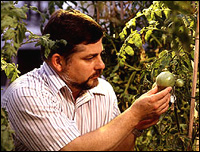Dear Umbra,
Is most of the genetically modified food that makes its way into our grocery aisles really that harmful? It seems to me that the process of genetic modification is not that far from hybridizing and other tinkering processes that we’ve come to accept.
Judi
Boston, Mass.
Dearest Judi,
We don’t know, and that’s the problem. The field is rife with dogma. Companies that genetically modify food crops claim safety, environmental and consumer groups claim alarm, scientists argue, and food-safety agencies — well, I don’t know what they’re doing. Not enough.

“These hybrid grapes would
make a hearty and
healthful snack,”
thinks Scientist A.
Photo: USDA.
Hybridization of a plant or animal occurs within species, and it is a type of “genetic manipulation,” in that hybrids are genetically distinct and would not occur in large numbers without our interference. Still, hybridization is a form of sexual reproduction, so it’s not possible to hybridize (mate) a mango and a cow to get mango-flavored milk, to take one example. Genetic manipulation in the laboratory brings us over that pesky hurdle and makes it theoretically possible to grow a cow with tropical udders. The flavor-laden gene could be lifted from a mango and injected, inserted, or blown into the proper bovine milk gene, and then it’s just a morning of milking, a day of yogurt making, and — ta da — a mango lassi!
I’m surely playing a bit fast and loose with Science here, but I hope you get a general picture of the difference between hybrid and GM crops. It’s a creepy difference that doesn’t seem “natural,” but is that cause for alarm? Again, we don’t know.

“Maybe I shouldn’t have inserted the
frog gene into these
tomatoes,” thinks Scientist B.
Photo: USDA.
Opponents of GM food crops are asking that there be independent scientifically rigorous testing of each modified crop and that GM products be labeled so consumers at least have the option of avoiding modified crops. The potential for errors with genetic modification is sobering — the GM industry has engineered crops to be pesticide-resistant, to have long shelf lives, to incubate pharmaceuticals (“pharm crops”), and to achieve industrial pollutant remediation. The potential health harms of such crops include inadvertent allergenicity, development of antibiotic-resistant diseases, and the unintentional mixing of pharm crops with food crops. Environmental harms could include the invasion of non-modified fields and the creation of super-pests and super-weeds.
Let’s look at your visit to the grocery store. Many processed foods contain corn or soybeans. Someone had the brilliant idea to make it easier to spray the herbicide glyphosate on the world’s vast corn and soy fields by developing GM seeds resistant to glyphosate. Now you can drench the fields with glyphosate even while the corn is standing and kill all the plants but corn. Glyphosate-resistant (aka Roundup Ready) corn and soy have been wildly popular in the U.S. It’s highly likely that you’ll buy some on your next trip to the store and eat it for lunch. You have no way of knowing whether the corn syrup you ate was Roundup Ready and/or whether eating Roundup Ready corn syrup will harm you.
Some of us believe this is unjust and in itself harmful, not to mention irresponsible. The last major advance in agriculture was the advent of synthetic chemicals, seen as a 20th century miracle for farmers struggling to maintain productivity and fight pests. DDT was once considered a godsend — and it’s now one of legions of chemicals outlawed in the U.S. Are we so shortsighted as to not learn from our birth deformities and myelomas? Should we be the guinea pigs for chemical companies who will not police themselves? Should our government agencies ineptly bumble their way through regulating this latest revolution in agriculture, at our expense? Obviously, I don’t think so, and I highly recommend spending half an hour reading through literature on the matter. For starters, check out the Center for Food Safety, the True Food Network, and the Campaign to Label Genetically Engineered Foods.
Beanly,
Umbra


